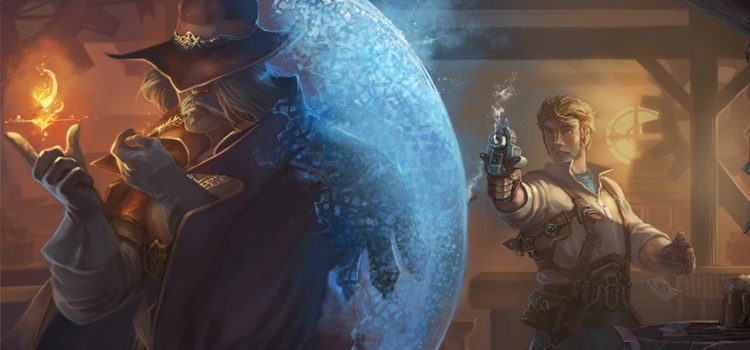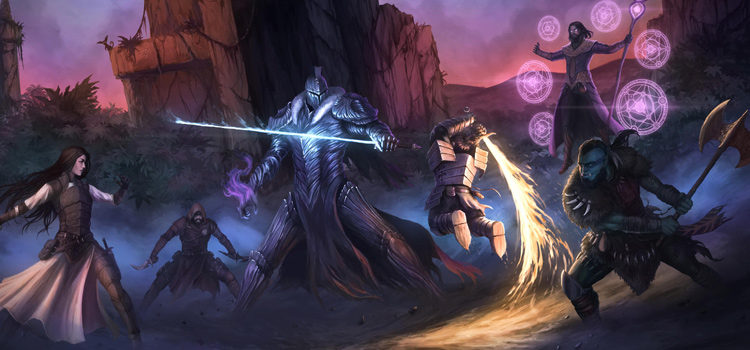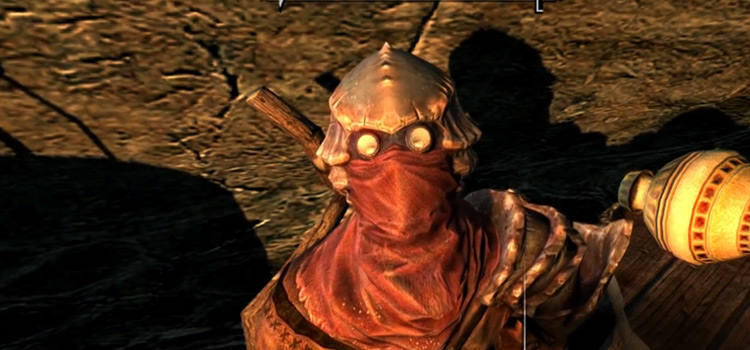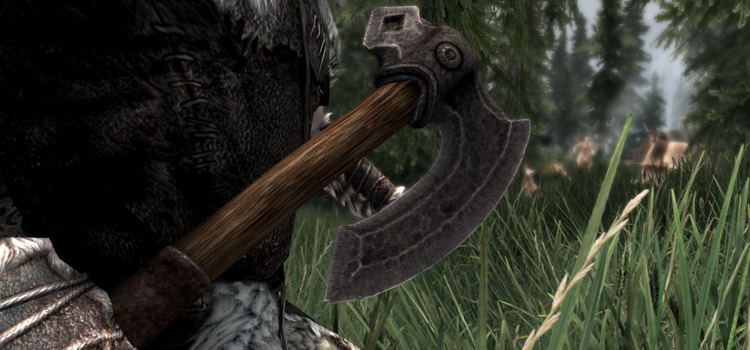Top 20 Best Feats In D&D 5e (Ranked)
This post may contain affiliate links. If you buy something we may get a small commission at no extra cost to you. (Learn more).
Great feats are game changing and character defining.
Feats should expand your character’s options and aim to always benefit your campaign.
If you forget you have a feat, then that feat probably wasn’t that good to begin with. But what should you be picking for your next build?
In this list, I do my best to pick out the best feats in the core D&D 5e source books: the Player’s Handbook and Xanathar’s Guide to Everything.
*Note: I intentionally left out the feats in Unearthed Arcana and Eberron – Rising from the Last War. Not only are a majority of those feats unimpressive, but they’re not Adventurer’s League legal.
20. Squat Nimbleness
Source: Xanathar’s Guide to Everything
Dwarves and Halflings become extra nimble.
Squat Nimbleness lets you gain 5 feet of walking speed, an increase to your Strength or Dexterity, proficiency in Acrobatics or Athletics, and gain advantage when trying to escape a grapple.
It’s a pretty simple feat with a lot of small benefits that, when combined, make Squat Nimbleness pretty good.
19. Elven Accuracy
Source: Xanathar’s Guide to Everything
Elven Accuracy is available to Elves and Half-elves.
When your attack roll involving Dexterity, Wisdom, Charisma, or Intelligence has advantage, you can take one of those dice rolls and reroll it.
This gives you three d20 rolls instead of the usual two.
This feat also increases your Dexterity, Wisdom, Charisma, or Intelligence by 1.
Maximizing your advantage is the name of the game with Elven Accuracy, which lands it a spot on this list.
18. Prodigy
Source: Xanathar’s Guide to Everything
Half-elves, half-orcs, and humans have access to this racial feat.
Choose one skill, tool, and language of your choice. And from then on, you’re now proficient. Nice!
Then choose a skill you’re already proficient with and you now double any proficiency bonus you gain from that skill.
Prodigy doesn’t stack with Expertise, but it’s a must-have for skill junkies.
17. Shield Master
Source: Player’s Handbook
With Shield Master, you become a shoving machine.
It was believed that with Shield Master, you could charge at your foes, shove them prone using a bonus action, and then attack them at an advantage.
While this would be incredibly powerful, the ruling in the 2019 Sage Advice Compendium has ruled that you can only shove them after all your attacks have been made.
This doesn’t mean Shield Master is useless. The ability to shove targets 5 feet or prone as a bonus action could be effective if coordinated well.
And Shield Master’s shove helps ranged allies keep their distance from enemies. If used right before another ally’s turn, your prone enemy is now an easy target for your party.
You could also shove enemies into a spell’s area of effect.
16. Mage Slayer
Source: Player’s Handbook
Mage Slayer is great if you want to play that melee anti-mage archetype.
When an adjacent creature casts a spell, you may make a melee attack on them as a reaction.
And when damaging a creature, you impose a disadvantage on them when they make concentration saving throws.
Additionally, your saving throws now have advantage against a creature’s spells if they’re adjacent to you. Snag this feat only if you encounter a lot of spell casters in your games.
15. Second Chance
Source: Xanathar’s Guide to Everything
Second Chance is a racial feat available to Halflings, and can be activated when a creature hits you.
When this triggers, you can force them to reroll that attack roll as a reaction. This ability can only be used once per initiative roll, or after a short or long rest.
I like to consider Second Chance as “Lucky junior” and an easy inclusion to this list.
14. Heavy Armor Master
Source: Player’s Handbook
You become so good at using heavy armor that you can deflect strikes.
Heavy Armor Master increases your Strength by 1, but becomes powerful with its other benefit.
You reduce all non-magical weapon damage by 3 when wearing heavy armor. This may not sound like a lot. But if you use Heavy Armor Master with a Battle Master’s Parry, then you can potentially decrease incoming damage by at least 11 points, if not more.
13. Mobile
Source: Player’s Handbook
Mobile increases your speed by 10 feet.
When taking this feat, you no longer need an extra turn to deal with difficult terrain while dashing. And you no longer provoke attacks of opportunity from your target whether or not you successfully land a melee attack on them.
This feat is simple. But if you’re looking to get in and out of combat situations, this is the go-to option.
The reason I’m not ranking Mobile higher on this list is because most encounters are usually designed in enclosed spaces.
There are also more important things to consider in an encounter than just repositioning yourself. Still, Mobile is a solid feat if you can pick it up.
12. Magic Initiate
Source: Player’s Handbook
If you choose the Magic Initiate feat, you get to choose from Sorcerer, Wizard, Cleric, Druid, Warlock or Bard. You then learn two Cantrips and a 1st level spell from the selected class’ spell list.
Magic Initiate is usually chosen because of its incredible versatility.
Choosing Magic Initiate could give you that extra edge in combat, or make use of utility spells you otherwise wouldn’t have access to.
With Magic Initiate, you also have access to Cantrips that scale with your level. Like Fire Bolt or Eldritch Blast.
You can gain a 1st level spell like Find Familiar for more utility, or Hex for more damage. Magic Initiate’s incredible versatility is usually worth it.
Keep in mind that whatever spell list you decide to borrow from, that class’ casting ability score is what you’ll use for your spells.
11. War Caster
Source: Player’s Handbook
War Caster is amazing on spellcasters.
The main reason to get War Caster is to gain advantage on Constitution throws when you take damage and want to maintain concentration on your spell.
War Caster also lets you use a spell when an enemy’s movement provokes an attack of opportunity from you.
This benefit isn’t as great, because you want to keep your distance as a spellcaster. Most enemies won’t move away from a spellcaster if they get close anyway.
The last benefit of War Caster allows you to do the Somatic component of your spell even while holding weapons or a shield. This is definitely useful if you’re a combat Bard or an Arcane Trickster.
The reason War Caster isn’t that high on my list is because of another feat that would serve you better for concentration checks. War Caster is a very good feat though, and certainly worth trying. But if you might want something a little better, well keep reading!
10. Alert
Source: Player’s Handbook
Alert easily makes it quite high on my list.
With Alert, you automatically gain a +5 to your initiative, will never be surprised when conscious, and avoid disadvantage on attack rolls against you when attacked by an unseen assailant.
The bonus initiative is incredibly potent on Strength-based characters, because they usually have bad Dexterity scores.
Being able to go first in an encounter, reposition, and deal out the first few hits makes encounters easier as a whole.
If you’re a Dexterity-based character, a Barbarian who gets an advantage on initiative checks, or a spellcaster, taking Alert is still worth it. Because it almost always guarantees you’ll go first to take out an enemy or control the battlefield.
The combination of going first and ignoring surprises makes Alert an excellent feat to pick up.
I can’t count how many times Alert has made an ambush trivial for my players.
9. Healer
Source: Player’s Handbook
Healer is one of the best utility and cost effective feats.
For an action, you can use a healer’s kit to stabilize your allies when they’re making death saves.
This alone is incredible.
Additionally, you can use a Healer’s Kit to heal a target once for 1d6 + 4 + a target’s level.
For something that costs only 5 gold and has ten uses, that’s amazing.
On top of that, you can use this feat again only after a short rest.
8. Sharp Shooter
Source: Player’s Handbook
The Sharp Shooter feat takes your character’s archery to the next level.
When you make an attack with a ranged weapon, you give yourself a -5 penalty to attack rolls for a powerful +10 bonus to damage.
This -5 penalty is offset by Sharp Shooter itself.
Sharp Shooter lets you ignore half cover and three-quarters cover, which would normally give your target extra AC. The other benefit is that you no longer roll at a disadvantage while using the longer range option of a ranged weapon.
Fighters and Rangers also have a tool to offset Sharp Shooter’s -5 penalty, because they get a +2 attack roll bonus from the Archery Fighting Style.
This feat almost feels like cheating for low to mid-level characters, and translates well into higher levels.
7. Crossbow Expert
Source: Player’s Handbook
If you’re planning on using a Crossbow, you have to take Crossbow Expert.
It allows you to ignore a crossbow’s loading property, and you no longer suffer a disadvantage on your ranged attacks.
What makes this feat top-tier is if you attack with a one-handed weapon as your attack action, you can attack using a hand crossbow as a bonus action.
Because a hand crossbow is a one-handed weapon, this feature also applies when attacking with a hand crossbow.
Now you have two attacks with your hand crossbow at the cost of one feat.
This makes Crossbow Expert exceptional at low levels where you would normally be doing single attacks. And this makes hand crossbows extremely viable, despite the lower damage dice it uses compared to a heavy crossbow.
6. Great Weapon Master
Source: Player’s Handbook
Now this feat is one of the most character-defining and well-loved feats in all of Dungeons & Dragons 5th edition.
When using a heavy weapon, you can choose to give yourself a -5 penalty to your attack roll to gain a solid +10 damage.
If you land a critical hit or bring a target to 0 hit points, you can use a bonus action to do an extra melee attack.
It’s insane when a Barbarian takes Greater Weapon Master, rages, and Reckless Attacks because of the advantage on attack rolls.
Not only will Reckless Attack overcome the -5 penalty, but you’ll be rolling two d20’s for every attack. Increasing the chance to land a critical hit and activating the extra attack from Great Weapon Master.
This feat is so good that you could make a Barbarian with as much Strength and Constitution as you can get, and only get Great Weapon Master, and you’ll still have one of the most dangerous builds available.
Make use of Bless, or find ways to get an advantage on your attack rolls to make the most of this incredible feat.
5. Resilient
Source: Player’s Handbook
The reason War Caster isn’t as high up on this list is solely because of Resilient.
Resilient gives you an increase to any ability score of your choice by 1, and you gain proficiency in saving throws associated with that ability score.
Now this feat is a simple and effective way to round out odd ability scores from character creation.
Resilient lets you secure proficiency with two out of the three most common saving throws in 5e, which are Constitution, Dexterity, and Wisdom.
Your class is already proficient with at least one of those three. So Resilient should let you grab another.
For heavy armored fighters, Wisdom and Dexterity are usually bad, so Resilience could help you cover at least one of those weaknesses where your AC won’t save you.
This is why if I had to choose between Resilience and War Caster, Resilience pulls ahead. Because it’ll also help concentration checks.
4. Bountiful Luck
Source: Xanathar’s Guide to Everything
Bountiful Luck is so good that I’m always tempted to play a Halfling if no one else wants to.
For players who understand that killing the evil villain and traversing dungeons involves more than hitting stuff with a big axe, you’ll love Bountiful Luck.
This feat lets you reroll for your allies within 30 feet as a reaction if they roll a 1.
The fact that this can be used every round, and works for attack rolls, saving throws, and ability checks, makes it incredibly broken. You’ll be surprised how common 1’s come up, and Bountiful Luck protects your party from those disastrous rolls.
3. Polearm Master
Source: Player’s Handbook
If you liked Crossbow Expert, Polearm Master is the melee equivalent.
Using a weapon with reach, you can take a bonus action to use the butt-end of your weapon to deal 1d4 of damage. This 1d4 damage applies the same ability score for the damage roll you used for your main attack.
This feat affects glaives, halberds, spears(very exciting), and quarterstaffs.
Polearm Master synergizes well with Greater Weapon Master because the halberd and glaive are both heavy polearms. This combination is the basis for an awesome melee damage dealer.
You’ll be able to get extra attacks with your bonus action, and enemies coming towards you get hit.
Barbarian’s Rage, Paladin’s Smite, or Battle Master’s Maneuvers all benefit from more attacks.
If you’re interested in a character that uses a Polearm, then Polearm Master will easily supercharge your build.
2. Sentinel
Source: Player’s Handbook
Buckle up, cause Sentinel is one of the most powerful feats you can get if you’re playing a tank.
Anyone hit by your opportunity attacks is stopped by dropping their speed to 0. If that wasn’t good enough, enemies can’t disengage to avoid opportunity attacks. So if you land that hit, the target is not going anywhere.
Finally, if a creature does happen to hit an ally and is within 5 feet of you, you can use a reaction to attack them.
Sentinel is the ultimate feat for keeping foes off your party members.
Combine this feat with Polearm Master and anything within 10 feet of you, simply can’t ignore you.
Even though you only get one reaction per turn, Polearm Master and Sentinel both give you so many conditions to trigger one, that you can easily control the pace of an the encounter.
This will be your go-to move when you use a melee weapon with reach. When an opponent moves close to attack, you stop them 10 feet away, because of Sentinel and Polearm Master’s opportunity attacks.
Then you can attack them on your turn and move back 5 feet.
Unless your target has long reach as well, this combination can easily be abused.
And this is what makes this feat so powerful. Even without Polearm Master, Sentinel is a very strong feat on its own. And if it were not for the next feat on my list, I would’ve put Sentinel at the top.
1. Lucky
Source: Player’s Handbook
Lucky is, hands down, the best feat in 5th edition.
This amazing feat grants 3 luck points that you can use to roll an additional d20 on an ability check, an attack, or a saving throw.
You may then choose which dice to use for the outcome.
Though you have to use this before knowing whether you succeeded or failed, Lucky can bail you out of those bad situations.
It doesn’t have to be a 1 to trigger, because any d20 roll you make can be rerolled up to 3 times.
Also if you’re in a bind and you’re attacked, you can use one luck point to roll a d20. Then you choose whether you use your roll, or the enemy’s roll. If you and your opponent both use Lucky to influence the outcome of a dice roll, they cancel each other and no one rolls that extra d20.
Lucky is a feat that all characters should seriously consider taking at any point of the campaign.
It’s basically getting advantage on demand.






